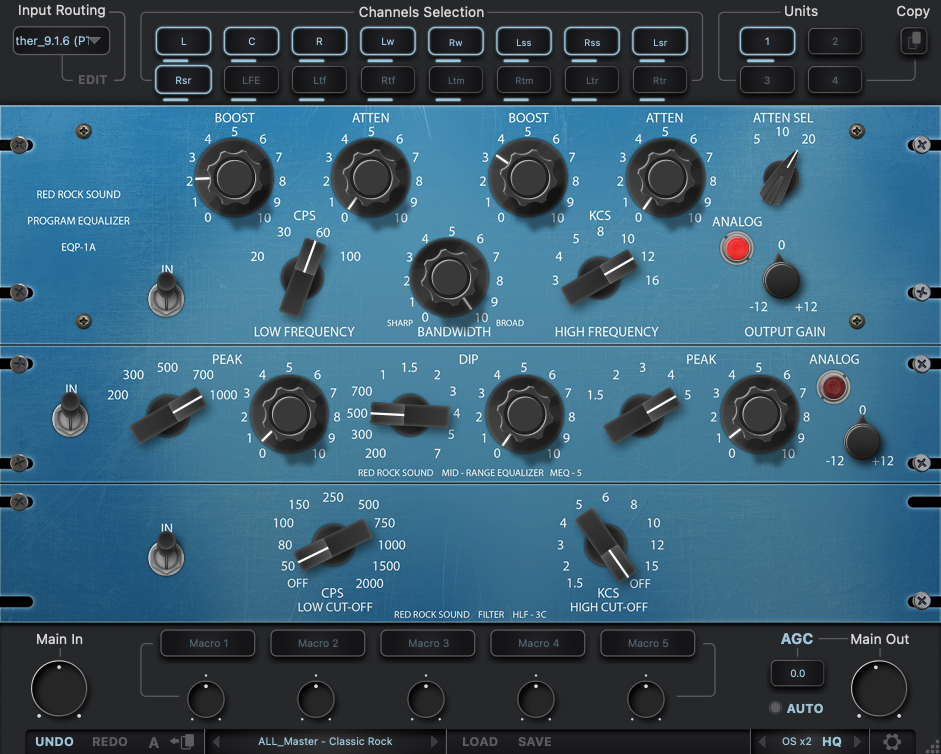Timeless equalizers
revitalized.

Interesting facts:
The Passive EQ Collection was used on the mix for Aaron Lazar album "Impossible Dream".
Charted at #2 on Billboard's Classical Crossover Album chart in September, 2024.
The album was nominated for a Grammy Award for "Best Traditional Pop Vocal Album" in November, 2024.
Passive EQ Collection Immersive
The EQP-1A based on Classic Program Equalizer from the ’60s, original EQ is renowned for its unique ability to boost and cut the same frequencies simultaneously, thereby creating a resonant shelf, the EQP-1A faithfully models the overbuilt transformers and complex tube amplifiers of the original hardware.
The MEQ-5 based on Classic Mid-Range Equalizer from the '70s, with two bands of midrange boost and one band of midrange dip, the MEQ-5 gets the very best out of the «power region» where guitars and vocals can make or break a mix.
The HLF-3C completes the Passive EQ Collection. This plug-in has 12 dB per octave low and high cut filters, providing broad retro-tonal sculpting or bygone-era special effects, without the inconvenience of insertion loss found with the unamplified passive hardware.
Save time and avoid tedious manual workarounds with Passive EQ Collection plug-in designed from the ground up for fast, efficient work on mid/side, stereo and the objects, the beds (fixed channels) of immersive mixing environments.
INPUT ROUTING PANEL

Groups
This module allows you to select an equalizer from four available. The equalizers are arranged in series, this allows you to process channels with different equalizers settings.
For example: the first EQ is only the mid channel, the second EQ is only the side channel, the third Eq is the left and right channel. For multi-channel modes: the first Eq is only the left and right channels, the second EQ is the center channel, the third EQ is the LFE, etc.
You can rename Group Buttons for ease of use. To rename the selected Group button, right-click on the button.
In order to turn on the solo (listen) of the equalizer, double-click on the selected equalizer number. The equalizer in solo mode glows yellow, to exit solo mode, double-click again. For two-channel modes, only one equalizer can be solo mode. For multi-channel modes, one or more equalizers can be soloed.
To bypass Eq processing, press the selected equalizer number one click + shift. In bypass mode, the button will glow red.
You can also copy all equalizer settings to another equalizer. To do this, select the equalizer from which you want to copy the settings, then click on the copy button, then select the equalizer to which you want to copy the settings.
Input Routing
Input Routing lets you choose between 44 common channel setups, starting from Stereo up to 7.1.4 and 9.1.6. Simply select in the input routing module the channel setup that fits your track.
You can also create your own input routing profiles. 16 independent channels are available.
Click on the edit button next to the input routing selection display. Hold down the shift button and select the desired number of channels. Name selected channels in order. Then click save and name the profile.
Channels Selection
In this module, you can select (activate) the channels that the equalizer (group) will process.
EQP-1A SECTION
Control Grouping
The EQP-1A can control three frequency bands simultaneously, using three groups of interacting parameters.
The first group adjusts the low frequencies and has three controls: boost, attenuation, and frequency select. The second group adjusts the high frequencies and has three controls: boost, bandwidth, and frequency select. The third group also adjusts the highs and has two controls: attenuation amount and attenuation frequency select.
The placement and grouping of the sections and their related controls are shown below.

Low Frequency Controls
Low Frequency
This switch determines the frequency of the low shelf portion of the equalizer. Four frequencies are available: 20, 30, 60, and 100 CPS.
LF Boost
This knob determines the amount of low shelf gain to be applied to the frequency set by the CPS switch.
LF Attenuation
This knob (ATTEN) determines the amount of low shelf cut to be applied to the frequency set by the CPS switch.
Background
In the documentation supplied with hardware version of the EQP-1A, it is recommended that both Boost and Attenuation not be applied simultaneously because in theory, they would cancel each other out. In actual use however, the Boost control has slightly higher gain than the Attenuation has cut, and the frequencies they affect are slightly different too. The EQ curve that results when boost and attenuation are simultaneously applied to the low shelf is an additional feature.
High Boost Controls
High Frequency
This switch determines the frequency of the high boost portion of the equalizer. Seven frequencies are available: 3, 4, 5, 8, 10, 12, and 16 KCS.
HF Bandwidth (Q)
This knob sets the proportion of frequencies surrounding the center frequency (determined by the KCS switch) to be affected by the high boost (this is a bandwidth control). Lower values yield a narrower band and effect fewer frequencies.
HF Boost
This knob controls sets the amount of gain for the high frequency portion of the equalizer.
High Attenuation Controls
HF Attenuation Frequency
This switch (ATTEN SEL) determines the frequency of the high frequency attenuator. Three frequencies are available: 5, 10, and 20 KCS.
HF Attenuation
This knob (ATTEN) determines the amount of high shelf cut to be applied to the frequency set by the Attenuation Selector switch.
Analog
This knob controls the level of harmonics added to the signal. The distortion is mild and adds some coloration.
Output Gain
This knob is an output gain control. The available output gain range is ±12 dB.
MEQ-5 SECTION

The MEQ-5 provides exacting control of the «power region» in program material, that frequency range from about 300 Hz to 5000 Hz in which most of the sound energy is concentrated. The ear is especially sensitive to sounds in this region. In this region, even small resonances in studio acoustics and microphone and speaker responses are very evident in their effect on the listenability of the sound. Three independent sets of controls make it possible to boost on a peak curve at 200...1000 Hz while simultaneously boosting on a peak curve at 1.5...5 kHz, while simultaneously dipping at 200...7000 Hz.
Analog
This knob controls the level of harmonics added to the signal. The distortion is mild and adds some coloration.
Output Gain
This knob is an output gain control. The available output gain range is ±12 dB.
HLF-3C SECTION
The HLF-3C completes the Passive EQ Collection. This plug-in has 12 dB per octave low and high cut filters, providing broad retro-tonal sculpting or bygone-era special effects, without the inconvenience of insertion loss found with the unamplified passive hardware.
You can easily subtract the unnecessary frequencies in any instrument and sub-group so they stay wonderfully musical in the mix.
The original HLF-3C hardware unit is a true passive design: there are no input/output amplifiers and it does not require any external power. As a result, there is an inherent loss of signal level when using the HLF-3C hardware. The RRS HLF-3C plug-in compensates for this inherent signal loss for simplified use in the modern era: it has unity gain upon insertion (there is no insertion loss until one or both of the cut filters is engaged).

The HLF-3C interface is very simple and includes only three controls:
IN
This toggle switch is the plug-in bypass control. When in the down position (bypassed), plug-in processing is disabled altogether. The plug-in is engaged with the switch is in the up position. This switch can be used to compare the processed settings to that of the original signal;
Low Cut
This rotary switch specifies the cutoff frequency of the low cut filter. Ten frequencies are available: 50, 80, 100, 150, 250, 500, 750, 1000, 1500 and 2000 CPS;
High Cut
This rotary switch specifies the cutoff frequency of the high cut filter. Ten frequencies are available: 1.5, 2, 3, 4, 5, 6, 8, 10, 12 and 15 KCS.
The midrange MEQ-5, Passive Filter HLF-3C and the broadband EQP-1A together comprise a full range vintage EQ chain.
BOTTOM SETTINGS PANEL

Global Input Gain
Main Input Gain controls the overall input level of the plug-in input, before all fx modules.
Macro Control
In the studio, when working with hardware devices, they often turn knobs with both hands; on
a computer with one mouse, this is difficult to do, so we tried to implement something similar
using the Combo knob.
For convenience and speed up work, you can bind several parameters to one macro
controller.
For example: Link the Hi Gain parameter from all 4 «Fx selection" (The Fx selection is
located in the upper right corner of the plugin) to one
macro controller and control them all at the same time. Or bind two different parameters to
one controller, invert one of them and boost the lows and lower the highs using only one
macro controller. There are many possible uses, just try this.
To bind parameters to a macro controller, click on the Macro button.
Note: To rename a Macro button, right-click on the button and enter a
new name.
When the Macro button is active, additional parameters appear for
those controllers that can be controlled.
Select the parameter you want to control, it has 4 controllers, they correspond to the «Fx
selection" numbers (The Fx selection is located in the upper right corner of the plugin), select the one you need.
Adjust the parameter control sensitivity, right is positive
value (blue color), left is inverted (red color), To return
the knob to position 0, click twice. To return the knob to
position 0, double-click with the left mouse button.
OGC (Output Gain Control)
To activate the Output Gain Control mode, click on the OGC button.
Below is located Compensate display that after a while will show you the level difference. Click on it to compensate for the difference.
Auto Mode
Click on the "AUTO" button to turn it on. If the gain difference is bigger than the "gain tolerance" then the AUTO LED becomes yellow and the plugin actively adjusts the gain (you'll see the knob slowly rotating).
Note: For more detailed settings of the OGC mode, go to "Global Preferences".
Global Output Gain
Main Output Gain Main Output Gain controls the overall output level of the plug-in output, after all fx modules.
Undo/Redo
Undo and Redo functions allow undo and redo of changes made to the plug-in parameters.
A/B
A/B buttons allows you to load two independent settings and compare them quickly.
Preset Display
Factory presets are included in the plug-in installation, installed in the following locations:
Mac: Users\[user name]\Music\Red Rock Sound\RRS Passive EQ Collection\Patches
Windows: C:\Users\[user name]\Documents\Red Rock Sound\RRS Passive EQ Collection
You can save the current settings as the Default preset. - Full Reset – is the default preset
Load
Load button allows loading of presets not stored in the locations described above.
Save
Save button allows for save of user presets.
Oversampling
OS x_ activates 2x, 4x or 8x oversampling, 1x disables oversampling.
(note that when the HQ mode is on, CPU will be loaded more than usual).
HQ mode (HQ)
HQ mode is for oversampling, it adds a higher order antialiasing filter. It improves processing quality, but also leads to an increase of the CPU load.
Global Preferences
Button opens Global Preferences menu.
AGC SETTINGS
RMS TIME
By default, the RMS time (the averaging time for loudness calculation) is set to 2 sec. You can change it from 0.6 sec to 10 sec when the time indicator is displayed.
FILTER TYPE
Flat
This means that the signal is not processed (Flat) or filtered before measuring.
K-Weighted
This means that the signal is filtered (K-Weighted) before measurement (it's used by default).
SUSPEND COMPARISON
It is useful when you're in AUTO mode and your track has silent areas.
By default when "Suspend comparison" is enabled and the signal is very low, the plugin will not perform any activity (will not compare levels, cause the signal is too low, and will not adjust the gain in the AUTO mode).
By default the threshold for "suspend comparison" is set to -60 db.
AUTO
Auto gain tolerance (the amount of gain difference that makes AUTO active).
The right value is the maximum value of gain that AUTO can apply.
Maximum Positive or Negative Gain Adjustment
Use separate limits for gain adjustment allows you to set negative and positive auto limits independently. This way you can have AUTO adjustments ranging (for example) from -20 to +10 dB, or from -18 dB to +4dB, etc.
D3D / OGL / CPU (Windows)
This switch allows you to choose between GUI rendering engine:
Normally, no need in switching rendering mode manually, plug-in try to initialize D3D9 then OGL (if D3D9 failed) and CPU (if OGL failed) automatically. But if you have problems with the GUI, you can manually switch and test different rendering methods at work.
This switch is available only in the Windows version of the plugin. For the Mac version, this is not necessary.
Note: Drivers of some video cards (for example, Intel Arc A380) in D3D mode adversely affect the plug-in (periodic noise or whistle), if you encounter a similar phenomenon, use OGL or CPU.
SIMD optimization
This switch enables or disables SIMD optimization, it can be used by multichannel processing with high oversampling. It is undesirable to use in mono and stereo modes, SIMD only slows down the plug-in due to the overhead of splitting the data for optimization.
(Currently in beta testing)
SIMD MacOS
- In the ARM version, you can enable or disable NEON; - In the Intel version, you can enable or disable SSE2.
SIMD Windows
- In the Intel version, you can enable or disable AVX (if supported), or SSE2.
The Windows version has a limitation: if the CPU does not support FMA, then the optimization will not work, even if AVX or SSE2 is supported.
Note: Enabling/disabling SIMD is saved in the project for each plugin individually. i.e. if a specific instance of the plugin slows down, then you can enable SIMD for it, and others, if they are in the project, will not be affected by this optimization.
COMPATIBILITY




System requirements
All Red Rock Sound products require a computer with appropriate DAW host software (none of which are included).
Plug-in Activation requires Internet connection!
You can go offline as soon as plug-in is successfully activated.
Versions from 1.0.0 and newer of the Red Rock Sound plug-ins have the following minimum requirements:
Mac OS X 10.14.6 or higher for AU.
Mac OS X 10.14.6 or higher for VST.
Mac OS X 10.14.6 or higher for AAX. Latest version of iLok license manager.
Windows 7 or higher (Windows XP not tested).
Mac: Intel Core i3 / i5 / i7 / Xeon / Full Apple silicon support (M1 or higher).
Windows: Intel Core i3 / i5 / i7 / Xeon / AMD Quad-Core or newer.
In theory, any AAX, VST, VST3, AUv3 compatible host application should work. However, due to plug-in host differences between DAWs - and our own rigorous testing standards - we only officially test our plug-ins and instruments in the most recent versions of Pro Tools, Logic Pro, Cubase, Ableton Live, Studio One, Reaper, and Bitwig. Red Rock Sound plugins are not tested in non-listed systems, but they most likely work as long as the system requirements are met. We cannot guarantee a solution for issues in unsupported systems.